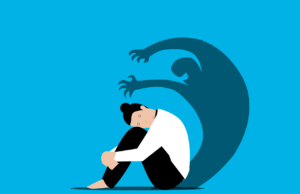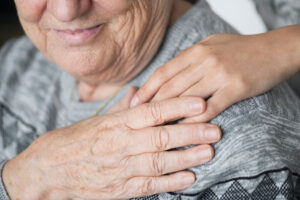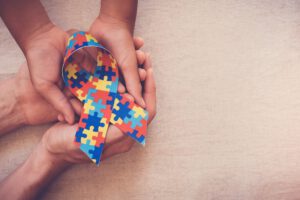
What is autism?

Autism is considered to be a neurologically-based, developmental disorder that is typically diagnosed in childhood. Even if recognized and diagnosed later, signs and symptoms from childhood must be present, according to DSM-V (2013), a psychiatric manual commonly used in diagnosis of mental conditions. The multi-disciplinary diagnostic team (e.g., psychologist, speech therapist, hearing specialist, psychiatrist) that establishes an ASD diagnosis gathers observations and information about the person’s early development/ functioning from a variety of sources. Both sensory as well as intellectual and language function should be examined.
Autistic Spectrum Disorder (ASD) affects how one behaves, communicates, learns, and interacts socially with others. Thus, it affects activities of daily living. Its symptoms are understood to be on a continuum or spectrum and may range from mild to moderate or severe.
At this time, in the United States alone, about 1.8% of chidren are diagnosed with ASD during childhood. Less is known about its adult presentation, and even less about probable gender differences. A large longitudinal study to explore early development to “help identify factors that may put children at risk for ASD and other developmental disabilities” is currently under way in the United States, spanning six medical centers (see CDC – Center for Disease Control and Prevention website.) It is hoped that understanding the risks may also help one learn more about the causes of ASD, which, like with most things, are believed to reflect an interplay between genetics and environment.
Since individuals diagnosed with ASD as children are likely to undergo changes in their behavior and symptomatolgy as they grow up, and since co-occurring heath conditions may emerge throughout adolesence and young adulthood, additional research is under way e.g., under the auspices of the CDC Study to Explore Early Development (SEED) Teen program.
Presentation
It is beyond the scope of this article to address the clinical presentation of children with an ASD diagnosis. Moreover, as mentioned, both gender and individual differences must be taken into account. Within the ASD community, there is increasing awareness that the clinical presentation of girls and women varies from that of boys and men.
A characteristic feature or hallmark of autism is experiencing difficulty or impairment with social interaction and communication. There may be discomfort with eye-contact or touch, difficulty with initiating small talk or maintaining a conversation and other difficulties that may become apparent in attempting to form close relationships or shying from them.
The ASD individual is often preoccuppied with deciphering and making sense of the other person’s intentions and verbal and nonverbal communications and may misinterpret some of them e.g., perhaps taking them at face value in a naive or literal fashion. People with ASD diagnoses tend to be mentally and emotionally overloaded by the very same social/relational processes which neuro-typical individuals might enjoy. Grandin, a scientist living with ASD, described feeling like “an anthropologist on Mars” in her attempts to make sense of the humans around her.
The constant struggle to and inherent frustrations of trying to understand and keep up with others in varying contexts may lead to a difficulties with self -regulation. Moreover, in their struggle to belong, some individuals will invest considerable energy in “masking” or “camouflaging” their difficulties, in order to “pass” as apparently normal, even though they may feel quite alienated. Eventually, this may lead to what has been described as “autistic burnout or shutdown.” Whereas people with ASD may lack verbal skills, their visuospatial skills may be exceptional (Grandin, 1996).
In order to feel safe, ASD individuals are dependent on an established routine and tend to have trouble with unexpected changes. Certain ritualistic behaviors may emerge to provide cobtinuity of experience and bolster safety. In some cases, people with ASD may develop a great interest in a particular topic, and perhaps embark on a monologue on the subject, regardless of the degree of interest (or lack thereof) the other may exhibit.
It is crucial to differentiate between autism and other conditions. For example, it is important to differentiate between what we commonly refer to as depression in a neuro-typical individual and what some autistic people might refer to as “autistic shutdown,” a much-needed resting period in order to recover from the tremendous effort of engaging in everyday activities in over-stimulating environemnts, such as shopping for food in a large supermarket, working or attending a social event, whther big or small.
As with many medical or psychological conditions, there is also the possibility of co-morbity or overlap.
Prevalence & risk factors
Autism is more prevalent in males – some estimate a 3 to 1 ratio.
Over the past fifty years, there is greater recognition of this condition, whose definition has expanded from being more circumscribed to being one on a spectrum. Relatively little is known regarding girls and women with autism, and it appears that autism is underdiagnosed in girls. Some adult women self-diagnose themselves upon recognizing themselves in others, for example, upon watching YouTube videos. Few professionals (e.g., psychiatrists, psychologists) have specialized in this area and there is yet a paucity of evidence-based research to support the diagnostic process and/or treatment planning.
Being on the spectrum seems to run in families. One of the common pathways to a diagnosis is having a sibling diagnosed— apparently, 1 in 5 families with one autistic child tend to have another child on the spectrum. Contrary to previous commonly-held but erroneous beliefs, according to Dr Carlone, a pediatrician and associate professor from the University of Utah, “parents do not cause autism” (Carlone, 2020, cited in the New York Times). In fact, to date there are no known causal factors. However, several associated risk factors have been identified, including rare mutations, increased parental age and preterm birth. There is inconclusive evidence regarding pesticides and air pollution; additional factors that were apparently ruled out include parental smoking, SSRIs (a type of anti-depressant medication), C-section, fertility treatments, and vaccines. A complex interaction between environmental and genetic factors has been proposed and is being explored.
Research
Many of the symptoms associated with ASD may be understood via the prism of the polyvagal theory, that thanks to Porges (2019), has provided a fresh understanding of diverse mental and emotional “psychiatric” conditions, including PTSD and autism. It illuminates our understanding of phenomena such as lack of facial affect or emotional expressivity, poor vocal intonation and prosody, sensitivity to noise, digestive and cardiovascular problems.
According to Stephan Porges, a scientist based in Indiana and North Carolina, our behavior and emotions are intimately connected with and influenced by the neural regulation the autonomous nervous system (ANS) provides our internal bodily organs and multiple, underlying bi-directional brain-body connections in play. The nervous system is constantly scanning the environment for signs of safety and danger, and we respond accordingly. Our responses to threat and danger are pretty much hard-wired, occurring before the thinking brain (cortex) kicks in. In autism, the sympathetic response of fight or flight is more pronounced than the ventral vagal one of safety and social connection, which is depressed. This is the science behind accounts of uncontrollable temper tantrums and meltdowns, which are understood as responses to perceived threat (cues of danger) and a pervasive sense of lack of safety in social engagement with others. It follows that treatment involves the development of more possibilities or islands of safety, which help defuse some of the triggers of danger. The safer we feel, the more we can socialize with others. Porges has develped an auditory program that stimulates the ventral vagal nerve and bolsters a sense of safety. This creates a window of opportunity for timely interventions, designed to promote positive experiences with others while the autistic person is neurologically “open” to this. Initial research results appear promising.
References
CDC – Center for Disease Control and Prevention website.
https://www.cdc.gov/ncbddd/autism/seed.html (last accessed, 11/6/2022).
Grandin, T. (1996). Thinking in Pictures and Other Reports From My Life With Autism. New York: Vintage.
Porges, S. (2019). Brain-body connection may ease autistic people’s social problems. Spectrum. Autism Research News.
https://www.spectrumnews.org (last accessed, 12/6/2022)
Zeliadt, N. (2020). What Causes Autism? New York Times. Updated, March 1, 2021
https://www.nytimes.com/2020/04/20/parenting/autism-causes.html (last accessed, 11/6/2022)









